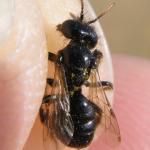A small, all black, scantily-haired bee with dirty-yellow scopae on the hind legs on the female. The male has distinctive pegs underneath the hind femora. In dull weather males are often found curled up in the flowers of yellow Asteraceae, especially hawkweeds. They may stay shut inside the closed flower overnight.
Known from southern England and Wales. It is also present in the Channel Islands. This species is much less widespread in occurrence than P. banksianus. Overseas, this species occurs in Europe, from Finland south to Spain, and east to Turkey and the Urals.
This species is not regarded as being of conservation concern.
Associated with short, heathy, grasslands over sandy or sandy-clay soils.
Univoltine, June to September.
Nests in aggregations in the ground, often at the edges of paths or other areas of bare ground. Nest entrances are often shared by a number of females.
Yellow-flowered Asteraceae.
Nomada fuscicornis Nylander has been recorded as a cleptoparasite in the Channel Islands. However, N. fuscicornis is currently unknown elsewhere in the region covered by this atlas.


